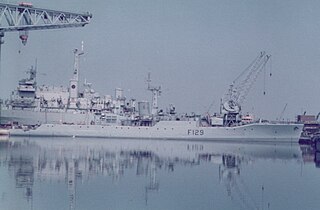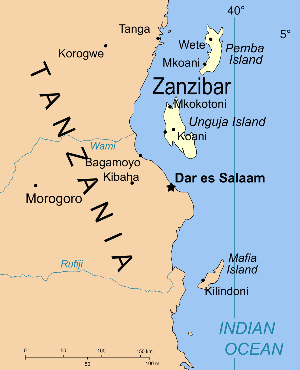
Zanzibar is an insular autonomous region of Tanzania. It is composed of the Zanzibar Archipelago in the Indian Ocean, 25–50 kilometres (16–31 mi) off the coast of the mainland, and consists of many small islands and two large ones: Unguja and Pemba Island. The capital is Zanzibar City, located on the island of Unguja. Its historic centre, Stone Town, is a World Heritage Site.

The Allied invasion of Sicily, codenamed Operation Husky, was a major campaign of World War II, in which the Allies took the island of Sicily from the Axis powers. It began with a large amphibious and airborne operation, followed by a six-week land campaign, and initiated the Italian Campaign.

Operation Barras was a British Army operation that took place in Sierra Leone on 10 September 2000, during the late stages of the nation's civil war. The operation aimed to release five British soldiers of the Royal Irish Regiment and their Sierra Leone Army (SLA) liaison officer, who were being held by a militia group known as the "West Side Boys". The soldiers were part of a patrol that was returning from a visit to Jordanian peacekeepers attached to the United Nations Mission in Sierra Leone (UNAMSIL) at Masiaka on 25 August 2000 when they turned off the main road and down a track towards the village of Magbeni. There the patrol of twelve men was overwhelmed by a large number of heavily armed rebels, taken prisoner, and transported to Gberi Bana on the opposite side of Rokel Creek.

Abeid Amani Karume was the first President of Zanzibar. He obtained this title as a result of a revolution which led to the deposing of His Majesty Sir Jamshid bin Abdullah, the last reigning Sultan of Zanzibar, in January 1964. Three months later, the United Republic of Tanzania was founded, and Karume became the first Vice President of the United Republic with Julius Nyerere of Tanganyika as president of the new country. He was the father of Zanzibar's former president, Amani Abeid Karume.

The Zanzibar Revolution occurred in 1964 and led to the overthrow of the Sultan of Zanzibar and his mainly Arab government by local African revolutionaries. Zanzibar was an ethnically diverse state consisting of a number of islands off the east coast of Tanganyika which had been granted independence by Britain in 1963. In a series of parliamentary elections preceding independence, the Arab minority succeeded in retaining the hold on power it had inherited from Zanzibar's former existence as an overseas territory of Oman. Frustrated by under-representation in Parliament despite winning 54% of the vote in the July 1963 election, the mainly African Afro-Shirazi Party (ASP) allied itself with the left-wing multiracial Umma Party, and early in the morning of 12 January 1964 ASP member John Okello mobilised around 600–800 revolutionaries on the main island of Unguja. Having overrun the country's police force and appropriated their weaponry, the insurgents proceeded to Zanzibar Town where they overthrew the Sultan and his government. Reprisals against Arab and South Asian civilians on the island followed; the resulting death toll is disputed, with estimates ranging from several hundred to 20,000. The moderate ASP leader Abeid Karume became the country's new president and head of state, and positions of power were granted to Umma party members.
John Gideon Okello was a Ugandan revolutionary and the leader of the Zanzibar Revolution in 1964. This revolution overthrew Sultan Jamshid bin Abdullah and led to the proclamation of Zanzibar as a republic.

Unguja is the largest and most populated island of the Zanzibar archipelago, in Tanzania.

The Aden Emergency, also known as the Radfan Uprising, was an armed insurgency by NLF and FLOSY during the Cold War against the Federation of South Arabia, a protectorate of the United Kingdom, which now forms part of Yemen.

The Sultanate of Zanzibar, also known as the Zanzibar Sultanate, was a state controlled by the Sultan of Zanzibar, in place between 1856 and 1964. The Sultanate's territories varied over time, and at their greatest extent spanned all of present-day Kenya and the Zanzibar Archipelago off the Swahili Coast. After a decline, the state had sovereignty over only the archipelago and a 16-kilometre-wide (10 mi) strip along the Kenyan coast, with the interior of Kenya constituting the British Kenya Colony and the coastal strip administered as part of that colony de facto.

HMS Rhyl was a Rothesay-class or Type 12I anti-submarine frigate of the Royal Navy, launched by Lady Macmillan on 23 February 1959 and commissioned in October 1960. Following Royal Navy service she was sunk as a target in 1985.
Abdulrahman Mohamed Babu was a Zanzibar-born Marxist and pan-Africanist nationalist who played an important role in the 1964 Zanzibar Revolution and served as a minister under Julius Nyerere after the island was merged with mainland Tanganyika to form Tanzania. He was jailed by Nyerere from 1972 and, after his release following an international campaign, remained a vocal critic of imperialism, authoritarian states and excessively statist development models.
People have lived in Zanzibar for 20,000 years. History properly starts when the islands became a base for traders voyaging between the African Great Lakes, the Somali Peninsula, the Arabian peninsula, Iran, and the Indian subcontinent. Unguja offered a protected and defensible harbor, so although the archipelago had few products of value, Omanis and Yemenis settled in what became Zanzibar City as a convenient point from which to trade with towns on the Swahili Coast. They established garrisons on the islands and built the first mosques in the African Great Lakes Region.
The Umma Party was a Marxist political party in Zanzibar. It was founded in 1963 by disaffected socialist Arabs from the ruling Zanzibar Nationalist Party and had several internal factions, including Marxist-Leninists, Maoists, and anarcho-socialists. It was led by Abdulrahman Muhammad Babu and supported the Afro-Shirazi Party during the 1964 Zanzibar Revolution. Babu was made Minister of External Affairs following the revolution. The party merged into the Afro-Shirazi Party on 8 March 1964.

Operation Boris was a British plan for military intervention in Zanzibar following the 1964 revolution. It was devised around 20 February to be used if the radical left-wing Umma Party attempted to take power. It replaced the earlier sea-based Operation Parthenon with a parachute assault launched from Kenya. However the operation was not required and was jeopardised by the lack of co-operation from the Kenyan government and populace for an attack on Zanzibar. Boris was replaced by Operation Finery, an amphibious helicopter assault, on 9 April 1964.

Operation Finery was a British plan for military intervention in Zanzibar following the 1964 revolution. It was a replacement for the earlier operations Parthenon and Boris, amphibious and airborne assaults. Finery circumvented the reliance of the previous plans on bases in Kenya, where government and local support for intervention were not forthcoming. Instead, Finery would have utilised the commando carrier HMS Bulwark to land Royal Marines on Zanzibar to protect Karume's government. Because of delays in the deployment of Bulwark, Finery was supplemented by Operation Shed, which could be launched at shorter notice. The expected coup did not occur, and Finery was scrapped on 29 April 1964, although Operation Shed remained in place.

Operation Shed was a British plan for military intervention in Zanzibar following the 1964 Zanzibar revolution. It was one of a series of operations devised by the British to be implemented in the case of an attempt to seize power from President Abeid Karume by the radical left-wing Umma Party. Shed succeeded the earlier Operations Parthenon and Boris and was an alternative to Operation Finery. Shed would have involved an airlift of a battalion of troops to Unguja to provide support to Karume and to protect European citizens. The risk of a coup passed by 29 April 1964 and it was determined that any intervention would be opposed by Karume's forces and a Soviet training team. With this in mind Shed was modified on 9 June to an airborne assault by Royal Marine commandos from HMS Centaur, which would then be supported by the landing of a battalion and armoured cars from Kenya. The continuing presence of British and friendly nationals in Zanzibar complicated the matter and, around 23 September 1964, Shed was replaced by Plan Giralda.

Plan Giralda was a British plan for military intervention in Zanzibar following the 1964 revolution. Giralda was intended to be launched if the radical left-wing Umma Party attempted to launch a coup against the government of President Julius Nyerere's newly formed Tanzania. It was the fifth and final British plan for such an eventuality, following Operations Parthenon, Boris, Finery and Shed. Giralda would have required British Army units, Royal Marines and Royal Navy vessels from the Far East to be deployed to Zanzibar if a request was received from Nyerere. Follow on units would be sent after the main assault from the British garrison in Kenya. The operational constraints of sending troops over such long distances, the reluctance of the Kenyan government to weaken the British presence in their country, the reduction of Western presence in Zanzibar and the strengthening of the political situation in Tanzania made intervention unlikely and the plan was suspended in October 1964. The newly elected Labour government cancelled the plan in December.

Operation Vantage was a British military operation in 1961 to support the newly independent state of Kuwait against territorial claims by its neighbour, Iraq. The UK reacted to a call for protection from Sheikh Abdullah III Al-Salim Al-Sabah of Kuwait, and air, sea and land forces were in place within days. Iraq did not attack and the British forces were replaced by the Arab League. Iraq recognised Kuwaiti independence in 1963.

The People's Republic of Zanzibar was an African state founded in 1964, consisting of the islands of the Zanzibar Archipelago. It existed for less than a year before it merged with Tanganyika to create the United Republic of Tanganyika and Zanzibar, which would be renamed to Tanzania in October of that year.

The United Kingdom began a military intervention in Sierra Leone on 7 May 2000 under the codename Operation Palliser. Although small numbers of British personnel had been deployed previously, Palliser was the first large-scale intervention by British forces in the Sierra Leone Civil War. In early May 2000, the Revolutionary United Front (RUF)—one of the main parties to the civil war—advanced on the country's capital, Freetown, prompting the British government to dispatch an "Operational Reconnaissance and Liaison Team" (ORLT) to prepare to evacuate foreign citizens. On 6 May, the RUF blocked the road connecting Freetown to the country's main airport, Lungi. The next day, British soldiers began to secure the airport and other areas essential to an evacuation. The majority of those who wished to leave were evacuated within the first two days of the operation, but many chose to stay following the arrival of British forces.














